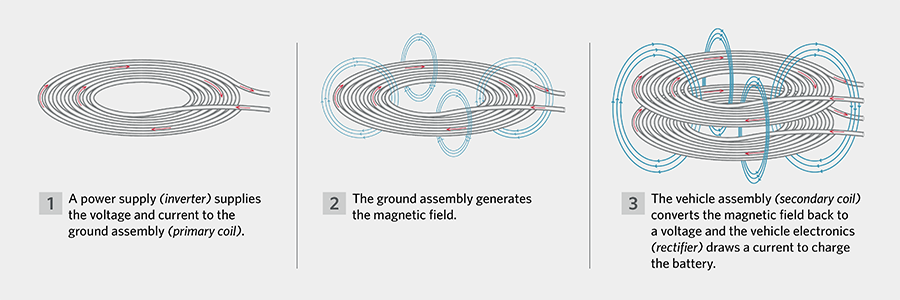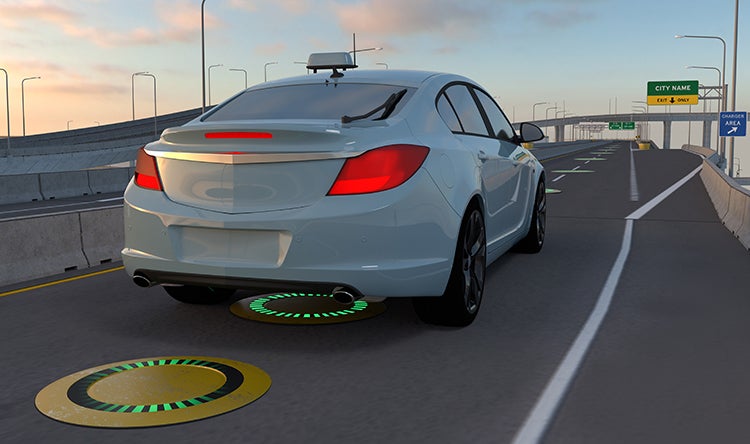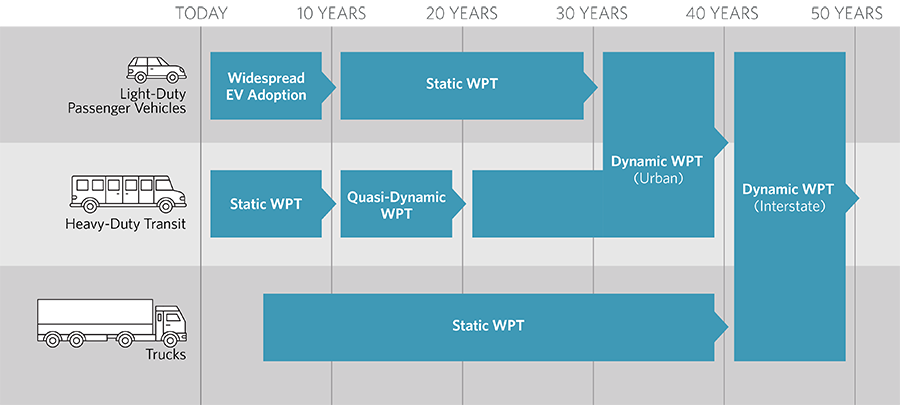
Experts Talk: Wireless Power Transfer and Electric Vehicle Applications with Thomas Stout
Experts Talk is an interview series with technical leaders from across our transportation program.
Why Inductive Charging Should Be Considered in Any Electric Vehicle Planning Effort
Imagine a world in which refueling your vehicle is as easy as parking, or even just driving in a particular lane. Wireless power transfer offers that possibility, allowing power to flow to electric vehicles through the air. Already in use around the world, the technology can provide numerous benefits to transportation agencies prepared to explore its possibilities.
Thomas Stout, Ph.D., has an extensive background as an electronic systems architect who helped design the first commercially available wireless charger for passenger electric vehicles. His work focuses on all aspects of wireless power transfer and its applications for transit, freight and passenger vehicles. In this article he shares some background on wireless power transfer, shares how transportation agencies are already using the technology, and discusses future applications and how agencies should be building WPT into their planning.
Wireless Power Transfer and Electric Vehicle Applications
Q. What is inductive charging or wireless power transfer?
A. It is a way to transfer power through the air with no cord, no cable, no plugs. It’s based on using an “air-gapped resonant transformer,” technology that has been around for more than a century. Though the concept has existed since the time of Nikola Tesla, its application in electric vehicles has only recently advanced, in the past 20 years or so, as electric vehicles themselves have become more widespread. Fundamentally, this air-gapped transformer works using the same principle as common utility transformers.
The transmitter is a coil of wire connected to a power source. When high frequency current is driven through the coil, it generates a magnetic field. When the receiver, also a coil of wire, is near enough to the transmitter, the magnetic field links the two coils together and induces a current, which generates voltage and can charge a battery. In the case of vehicle applications, the transmitter is usually placed on or under the ground, and the receiver is mounted to the vehicle, which drives over the transmitter. Other configurations, such as mounting the receiver on the vehicle roof and driving under a transmitter, are also theoretically possible.
This transfer of power from one inductor to another through a shared magnetic field is based on the concept of “mutual inductance,” which is where the name “inductive charging” comes from. It is also sometimes referred to as resonant, resonant inductive or resonance power transfer, because resonant capacitors are added to increase the efficiency of power transfer at certain frequencies.

Q. How are transportation agencies already using wireless power transfer technology today?
A. Today, WPT is primarily used in transit fleet applications. I have worked on several transit fleet transition studies which have found that transitioning a fleet to 100% electric is only feasible with a robust en-route charging solution. Wireless power transfer options are one practical solution to achieve this charging.
Installing WPT systems at strategic charging locations on bus routes allows bus batteries to be charged throughout the day rather than returning to a bus depot for one long charge. These en-route chargers are typically much higher power than a corded depot charger, providing power faster. This continual charging greatly increases the distance that a bus can cover in one day, in some cases even allowing for 24/7 operation. With en-route WPT a transit agency has a clear path to replacing diesel buses with electric buses at a 1-to-1 ratio.
Transit fleets have used WPT systems primarily for en-route charging, though it can also be part of a depot or garage-based charging system. Thorough research and planning can identify the best locations for charging infrastructure and help agencies match those locations with current or adjusted bus schedules to minimize costs and maximize efficiencies.
Q. What applications could wireless power transfer have in the future?
A. An industry standard for WPT on light-duty vehicles was just recently released, and in the next couple of years, we will start to see WPT as an option on passenger vehicles available directly from manufacturers. Other medium and heavy-duty vehicle applications will also find compelling use cases for WPT. This includes vehicles like delivery trucks and long haul trucks.
In the more distant future, dynamic WPT is the holy grail of electric vehicle charging. In this system, coils are embedded in the roadway pavement, creating powered sections of highway. Vehicles traveling over these sections could recharge their batteries at full speed. This has major implications for passenger vehicles but even greater implications for long-haul trucking and allowing for goods to be transported hundreds of miles without the need to carry extremely large batteries.
Dynamic charging infrastructure could also provide an alternative revenue stream for entities similar to toll roads, allowing the infrastructure owners to charge users for the power provided to their vehicles or for access to dedicated charging lanes. Any widespread dynamic WPT is likely many years away, but pilot programs around the world are already proving the technology’s viability today.

Q. How does wireless power transfer compare to other options such as plug-in or pantograph charging?
A. Comparisons of charging technology show that WPT is a long-lasting, practical and often more aesthetically pleasing choice. Importantly, WPT is capable of passing the same high power levels as plug-in or pantograph chargers. This is significant as power-level applications for transit systems can range anywhere from 50kW to 450kW, with increased power coming in the future.
Efficiency of the technology is also similar, with the efficiency of a WPT system typically within 1-2% of the efficiency of a corded charger.
There are also several ways that WPT is superior to corded technologies. Often buried in the roadway, WPT systems are largely unaffected by weather. Exposure to rain, snow, ice, salt and other elements can take a toll on mechanical parts and electrical contacts used in above-ground systems. Combined with a lack of moving parts, this means much less maintenance for WPT methods.
WPT can also be a more attractive aesthetic choice. The systems can be hidden away with no visible infrastructure, a stark contrast to the large overhead towers required by a pantograph. This ability to hide the technology can also be an advantage in settings where public vandalism or defacement is a concern.
As with many new technologies, a lack of information has led to some common safety concerns, with worries about the harmful effects of being exposed to the electromagnetic field. Multiple studies and research efforts have found that these worries are unfounded and the technology is very safe. Even before WPT was developed for vehicles, safety guidelines were in place for electromagnetic field exposure; guidelines that these WPT systems comply with. In addition, most systems include a foreign object detection system that can automatically shut down charging if needed.
Q. How should transportation agencies be incorporating wireless power transfer into their planning?
A. First, agencies need to be aware of its existence. Everyone, including transit agencies and DOTs, should be paying attention regardless of whether they are ready to actively pursue the technology. Transit agencies in particular should consider this as a charging option when looking to transition their fleets to electric buses. Since WPT is such a good fit for the needs of transit agencies, this is a technology they can take advantage of right now if they are willing to consider it.
Fleet owners that service limited areas such as college campuses or airport parking areas would also be well served to explore the possibilities of the technology, which can keep 24-hour electric shuttles running without long stops at a depot, for instance.
Wireless charging and its implications could affect all agencies, so they should make sure they understand where the technology is today and where it's going as advancements are made.
More forward-looking agencies should consider pilot programs, particularly in the dynamic WPT space. Pilot programs allow agencies to start answering some of the unknowns about this technology, like how power will be distributed along the roadway, how the electronics will be accessed and serviced on an active road, and how these coils will impact roadway maintenance operations. Also, any long-range planning for the impact of electric vehicles should also consider WPT as one piece of the larger puzzle.

Inspiration & Advice
Q. How did you become involved in wireless power transfer technology?
A. It wasn’t necessarily planned. It was an opportunity that came and I took it. I was an embedded electronics engineer creating designs for more generic embedded systems and began working for a company developing a wireless charger. Over time, I began working on the power electronics, then the resonant circuits and doing the coil design. Eventually I became the system architect, in charge of all aspects of wireless charging. In other words, I just grew into an expert in the field bit by bit.
Q. What advice do you have for someone who is interested in wireless power transfer technology and working in the field?
A. Get a handle on the basics. The engineering principles that are used to understand WPT are not all that complicated, but a lot of people approach it like it's magic. It's really not. Taking the time to understand it will let you understand where it works, where it doesn't, what it can do, what it can't and why. And that helps you apply the technology much more intelligently. You really need to understand the basics and how it works at a fundamental level and then build from there.
Each Experts Talk interview illuminates a different aspect of transportation infrastructure planning, design and delivery. Check back regularly to see new insights from the specialized experts and thought leaders behind our award-winning, full service consulting practice.




